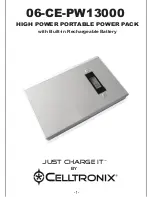
vi
©2011 Broadcast Electronics
HIGH VOLTAGE –
Many power circuits operate at voltages high enough to kill through electrocution. Personnel should
always break the primary AC Power when accessing the inside of the transmitter.
RADIO FREQUENCY RADIATION -
Exposure of personnel to RF radiation should be minimized, personnel should not be permitted in the
vicinity of open energized RF generating circuits, or RF transmission systems (waveguides, cables,
connectors, etc.), or energized antennas. It is generally accepted that exposure to “high levels” of
radiation can result in severe bodily injury including blindness. Cardiac pacemakers may be affected.
The effect of prolonged exposure to “low level” RF radiation continues to be a subject of
investigation and controversy. It is generally agreed that prolonged exposure of personnel to RF
radiation should be limited to an absolute minimum. It is also generally agreed that exposure should
be reduced in working areas where personnel heat load is above normal. A 10 mW/cm
2
per one
tenth hour average level has been adopted by several U.S. Government agencies including the
Occupational Safety and Health Administration (OSHA) as the standard protection guide for
employee work environments. An even stricter standard is recommended by the American National
Standards Institute which recommends a 1.0 mW/cm
2
per one tenth hour average level exposure
between 30 Hz and 300 MHz as the standard employee protection guide (ANSI C95.1-1982).
RF energy must be contained properly by shielding and transmission lines. All input and output RF
connections, such as cables, flanges and gaskets must be RF leak proof. Never operate a power tube
without a properly matched RF energy absorbing load attached. Never look into or expose any part
of the body to an antenna or open RF generating tube or circuit or RF transmission system while
energized. Monitor the tube and RF system for RF radiation leakage at regular intervals and after
servicing.
HOT SURFACES –
The power components in the transmitter are cooled by forced-air and natural convection. When
handling any components of the transmitter after it has been in operation, caution must always be
taken to ensure that the component is cool enough to handle without injury.
Summary of Contents for Marti Electronics ME-40
Page 10: ...viii 2011 Broadcast Electronics...
Page 15: ...5 2011 Broadcast Electronics...
Page 23: ...13 2011 Broadcast Electronics...
Page 36: ...26 2011 Broadcast Electronics FIGURE 5 1 POWER SUPPLY SIMPLIFIED SCHEMATIC DIAGRAM...
Page 39: ...29 2011 Broadcast Electronics Figure 5 3 PARALLEL LOAD CONNCTIONS...
Page 44: ...34 2011 Broadcast Electronics FIGURE 5 4 NO PA VOLTAGE TO THE RF AMPLIFIER...
Page 47: ...37 2011 Broadcast Electronics FIGURE 5 5 MODULATED OSCILLATOR SIMPLIFIED...
Page 59: ...49 2011 Broadcast Electronics TABLE 5 6 FREQUENCY SYNTHESIZER PROGRAMMING...
Page 62: ...52 2011 Broadcast Electronics FIGURE 5 8 NO RF OUTPUT LOCK IS EXTINGUISHED...
Page 66: ...56 2011 Broadcast Electronics FIGURE 5 10 RF Amplifier SIMPLIFIED SCHEMATIC...
Page 72: ...62 2011 Broadcast Electronics Figure 5 11 RF Amplifier Circuit Board Controls...
Page 74: ...64 2011 Broadcast Electronics This page intentionally left blank...
Page 91: ...BOM LEVEL PART NO DESCRIPTION QTY REF DES 81 2011 Broadcast Electronics 7 SCHEMATICS...
Page 94: ......
Page 95: ......
Page 96: ......
Page 97: ......
Page 98: ......
Page 99: ......
Page 100: ......
Page 101: ......
Page 102: ......
Page 103: ......
Page 104: ......
Page 105: ......
Page 106: ......
Page 107: ......
Page 108: ......
Page 109: ......
Page 110: ......
Page 111: ......
Page 112: ......
Page 113: ......
Page 114: ......
Page 115: ......
Page 116: ......
Page 117: ......
Page 118: ......
Page 119: ......
Page 120: ......
Page 121: ......
Page 122: ......
Page 123: ......
Page 124: ......
Page 125: ......
Page 126: ......
Page 127: ......
Page 128: ......
Page 129: ......
Page 130: ......
Page 131: ......
Page 132: ......
Page 133: ......









































